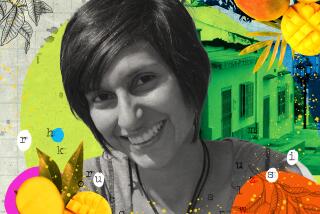A Foot in Two Worlds--and a Language for Both
Outside, in the cool morning air of what promises to be a hot and smoggy Los Angeles day, a kindergarten teacher stands at the head of a lunch table at Tenth Street Elementary School. Her students empty food from brown paper bags.
“What is this?” she asks.
“Milk,” they chorus. “Sweet bread.”
Native Spanish speakers, the children are soaking up English with their morning meals.
In Mrs. Ray’s music class, first-graders learn a ditty about gardens--they sing, in English, of carrots, tomatoes and pumpkins. In the arcane lingo of education, singing in the new tongue helps “eliminate the affective filter.” Simply put, it helps relax those who are intimidated by the language they must eventually learn.
Upstairs, in a computer lab, Mrs. Garcia’s fourth-graders sit at keyboards, typing invitations for their parents to a dance. This is a class “transitioning” from Spanish to English. Some are typing, “Dear Mom and Dad,” others, “Estimado Papa y Mama.”
Down the hall, in Mr. Yee’s fifth-grade class, Sandy Vasquez faces her classmates and reads the book she created for the school’s annual Young Authors Fair. Almost every child in the school has created or collaborated on a book. Red hens, giant beets, ill-fated voyages, American history--the books express the lives and dreams and disasters of little kids everywhere. They also express something that might surprise foes of bilingual education: Somewhere between third and fifth grades, the books evolve from Spanish to English.
Mr. Yee’s students have based their books on episodes from their own lives; the narratives are startlingly personal. In Sandy’s “Two Homes at the Same Time,” she reveals her mother’s heartbreak over being separated from Sandy’s two brothers. The tale is told in English, with some Spanish dialogue.
Sandy wrote it that way because Mr. Yee encouraged his students to write their realities. And this is how they live, a foot in each world--Spanish at home; English at school.
*
Attempts to scrap bilingual education--fueled by the victory of Proposition 187--seem misguided in light of what happens at Tenth Street School, where children who enroll at 5 speaking one language matriculate at 11 speaking two.
The battle over the future of bilingual programs--raging now at a school district near you--is as much about xenophobia as it is about methodology. There are those (plenty of those) who bristle at the notion of our tax dollars funding foreigners who can’t be bothered to learn the language of the land.
“The English-only people are fighting a defensive battle,” says Mr. Yee. “You can smell it in the air.”
True. And I would offer in proof the unembellished fact that there are places around this town where the language of the land is Spanish, where you can easily live, work, shop, bank, watch TV, see movies and listen to the radio without learning a word of English.
But that is a side issue, a distraction from the real one, which is how best to produce literate, self-respecting children who will stay in school and maybe even go to college.
The theory that governs the curriculum at Tenth Street School is simple: If you can give kids an academic foundation in the language they know, acquiring a second language--English--will be easy. If you force them to learn a new language at the same time they are acquiring basic skills, you may be overloading them and setting them up for failure.
By the time most of these children reach middle school, they will be proficient in English without having abandoned Spanish.
Seems like a fairly painless way to acquire fluency in two languages. Shouldn’t that be the goal of any decent school system?
*
Take your pick of geopolitical cliches: the brave new world, the global economy, the Pacific rim. They’re all based on the idea that the planet is “shrinking” and that those destined for success will be the ones who can navigate all shores.
This, I believe, is the thinking behind the decision of the many white parents in my neighborhood who have sent their 5-year-olds off to bilingual kindergartens this year. These parents hope to give their kids a leg up in the world by helping them become literate in Spanish as well as English.
They are merely doing for their own what Mr. Yee and his colleagues are doing for the students at Tenth Street Elementary School: preparing them in the best way possible for life in a city that is neither English nor Spanish, but wonderfully both.
* Robin Abcarian’s column appears Wednesdays and Sundays. Readers may write to her at the Los Angeles Times, Life & Style, Times Mirror Square, Los Angeles, CA 90053.
More to Read
Sign up for our Book Club newsletter
Get the latest news, events and more from the Los Angeles Times Book Club, and help us get L.A. reading and talking.
You may occasionally receive promotional content from the Los Angeles Times.










